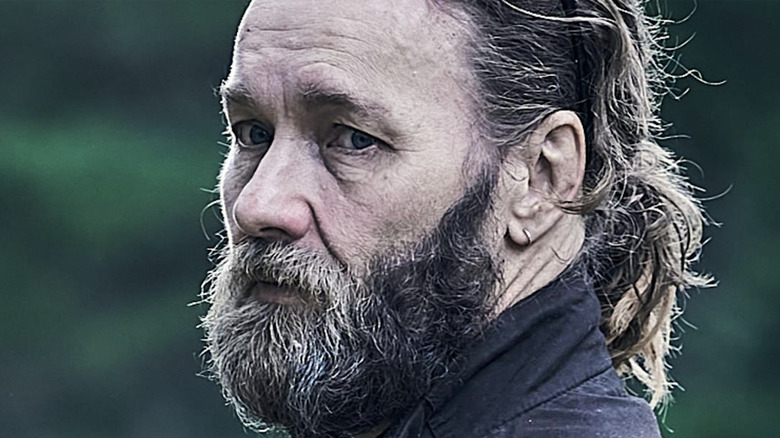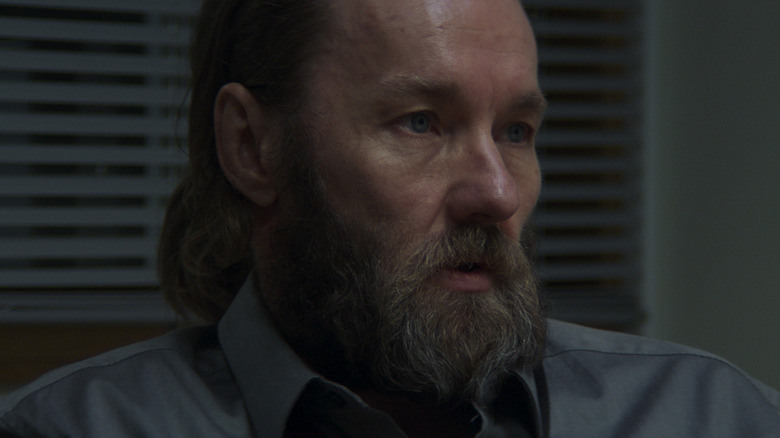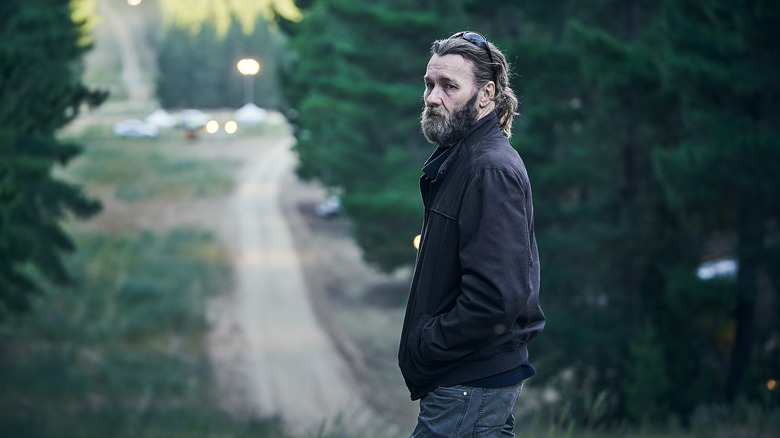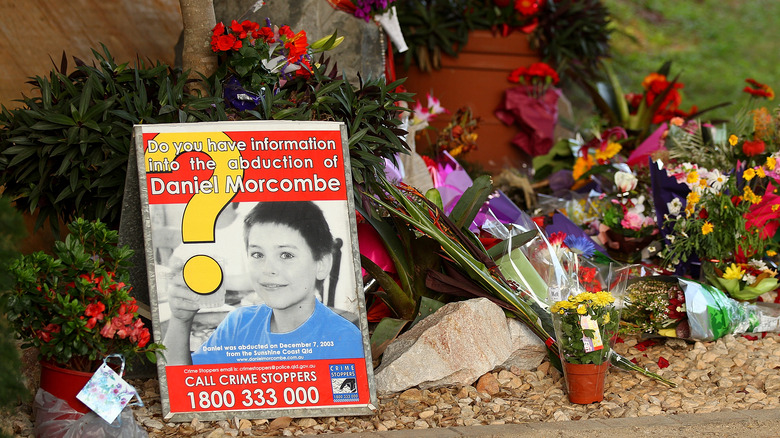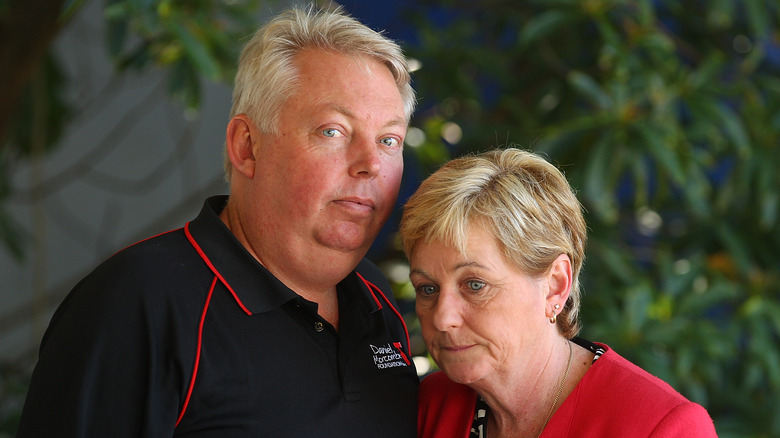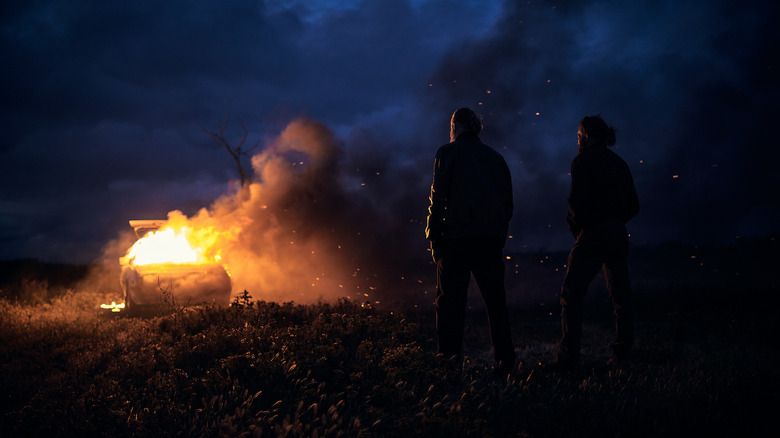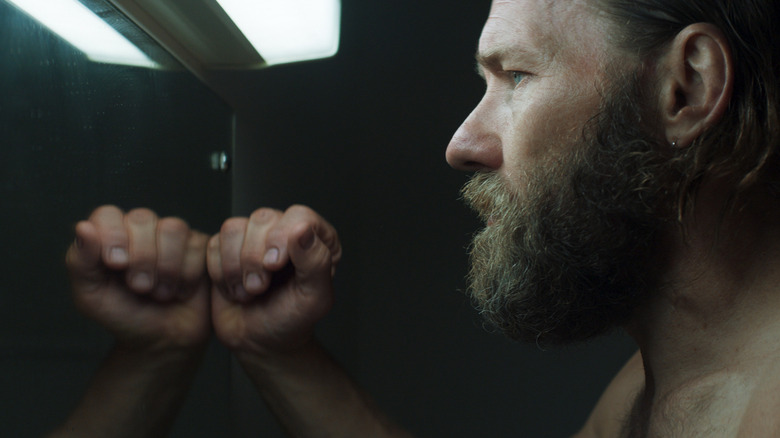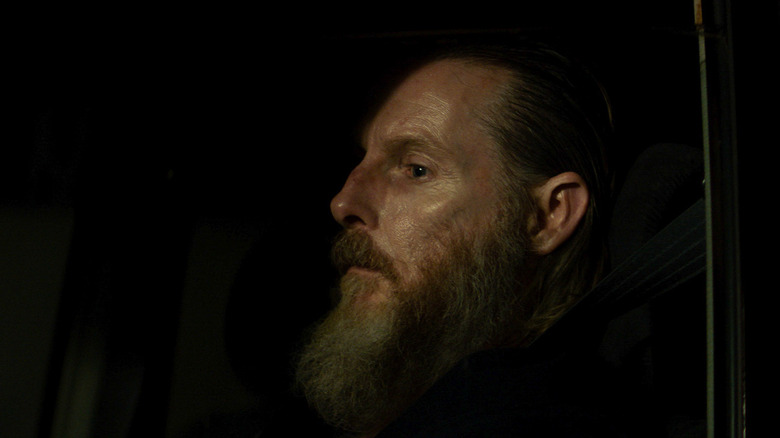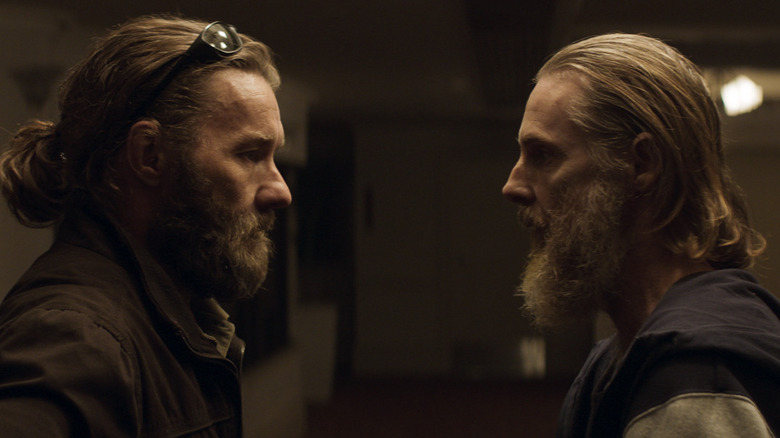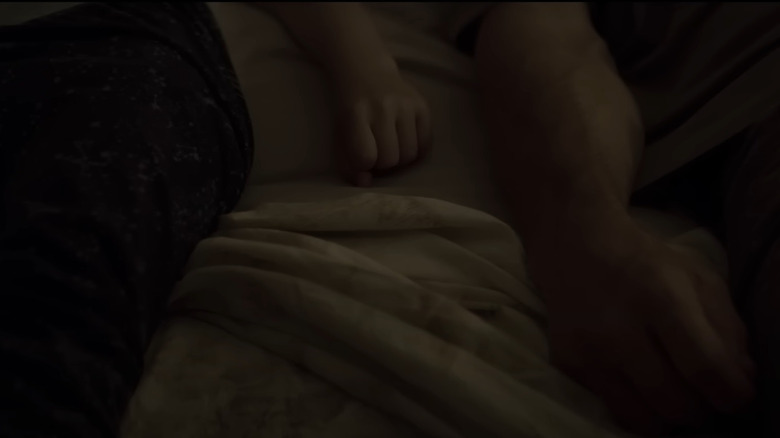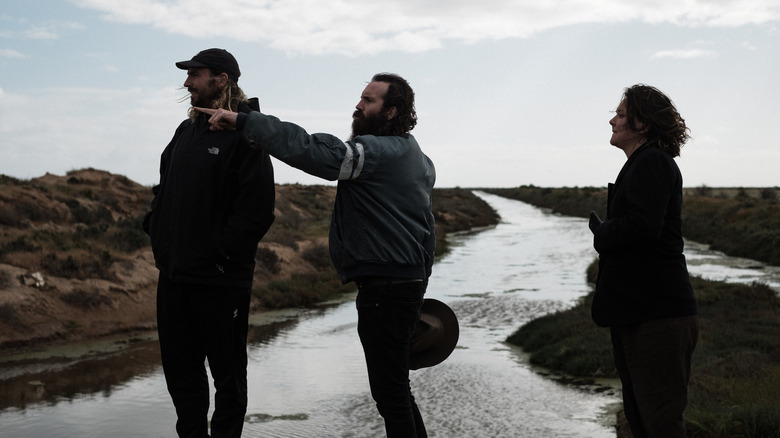The Ending Of The Stranger Explained
Netflix's "The Stranger” — directed by Australian actor-turned-filmmaker Thomas Wright — has become something of a sleeper hit on the streaming platform. Even though the movie received glowing reviews and a standing ovation at the Cannes Film Festival, Netflix placed "The Stranger" on its platform without much fanfare. Nevertheless, viewers are catching on to just how special the film is, bringing it to the Top 10 most watched movies category following its release.
"The Stranger" — based on a real life Australian police investigation into a murder — stars Joel Edgerton as undercover cop Mark Frame and Sean Harris as suspected killer Henry Teague. While its premise may make "The Stranger" sound like standard true crime fare, inspired direction and effective lead performances elevate its subject to a higher plane. "The Stranger" is psychologically tense, borderline surreal at times, and deeply meditative. With its singular approach to a movie category too often crippled by cliches, here's a (spoiler-heavy) breakdown of the movie's specifics — in particular, what happened in that thrilling final act.
The sting down under
"The Stranger" revolves around a months long police sting operation designed to cajole a suspected child murderer into giving undercover detectives a confession. For US-based viewers, it's worth pointing out this type of operation may seem unfamiliar because while it's legal in Australia, it's not in the United States.
In the film, the sting begins when an ex-con named Paul "happens" to run into ex-con and suspected murderer Henry Teague on a bus. Paul befriends Henry. Then, Paul introduces Henry to an organized crime syndicate. Henry meets his main contact and partner in the syndicate, "Mark Frame." But Mark isn't middle management in a criminal enterprise, he's actually an undercover cop. The syndicate itself isn't real either. Its members are entirely made up of undercover cops and the "work" it gives Henry and Mark is staged.
But since Henry believes he's among thieves looking to give him good money, he's lulled into a sense of obligation to his newfound company. The setup is not only ingenious because it encourages the cagey Henry to speak openly about his criminal past, but also makes for riveting viewing. Since the movie unfolds alongside the investigation, the audience is made to feel like they're alongside the undercover cops the entire time, slowly creeping towards the truth.
A meticulous search
After the film's climax — when Mark and other undercovers have finally extracted a confession from Henry — uniformed officers undergo a massive search across a four acre radius to find physical evidence of Henry's grisly murder. After the Herculean effort that went into gaining Henry's confession, some viewers may wonder why the cops need physical evidence.
Simply put: given the time since the crime occurred and the nature of the sting, police officials worry a jury would see a confession without physical evidence and assume it to be the result of coercion. So, the investigators need to find evidence to ensure Henry doesn't go free and kill again.
After an extensive search through forestry lands in rural Queensland — and a marvelously composed montage — one of the investigators raises a hand, signaling they've found a piece of evidence. The movie never explicitly shows the audience what the nameless officer found in the dirt, because there's no need. After almost two hours of watching Mark and other investigators dutifully go about their grueling work, a simple raised hand ends "The Stranger" on a cathartic note.
Fact vs fiction
As the movie opens, viewers are greeted by the phrase "based on a true story" flashing across the screen. While some may be skeptical as to how much of twisty narrative of "The Strangers” is based in reality, the plot's main beats are pulled from a real life Australian undercover operation.
"The Stranger" is based on author Kate Kyriacou's nonfiction work "The Sting: the Undercover Operation that Caught Daniel Morcombe's Killer." In 2003, 13-year-old Morcombe was abducted and murdered. Kyriacou's work details the ins and outs of the real life sting that brought the boy's kidnapper and killer to justice. As in the movie, actual investigators created a fake crime syndicate to trick a murder suspect with a false sense of comfort. This type of sting is known to investigators as the "Mr. Big" ruse or "Canadian technique."
In both the movie and real life, the Mr. Big operation was successful and Morcombe's murderer was brought to justice. In the film, however, the names of everybody has been changed.
Calls for a boycott
Given the heinous nature of the crime it details, "The Stranger" was met with controversy when news of its Australian release was announced; much of this was driven by the parents of the victim. Bruce and Denise Morcombe called for audiences to boycott the film before its premiere at the 70th Melbourne Film Festival.
As the film entered production, production company See Saw Films approached the Morcombes about their possible involvement. The pair declined, saying they felt doing so would be a "cruel, callous, selfish cash grab."
While the narrative dramatization of violent crimes can be treacherous, See Saw Films seems to believe that the altering of names and omission of violence (in particular, any recreation of the horrific crime itself) is enough to keep the film's intentions respectful. Such controversies aren't uncommon; just a few years ago, a similar situation arose around the release of Justin Kurzel's "Nitram," a movie depicting events leading up to the 1996 Port Author massacre.
Unsung heroes
One thing that may surprise viewers is the film's unflinching focus on the investigation to catch Henry Teague rather than any recreation of his crimes. The choice to zoom in on the officers behind a Mr. Big operation as intense as the one depicted in "The Stranger" was a conscious one.
In a 2022 interview, director Thomas Wright explained his intent to create a character study around special investigators like Mark Frame.
"The social contract between Mark and society is really eroded; he sees society held together by thin, thin fibers, separating us from the violence that's out there everywhere," the director explained. "I hope that cops will be able to watch this film and will feel that their work has been honored."
It's not hard to argue "The Stranger" achieves Wright's goal. While the film certainly doesn't make the work of special investigators in Mark's complicated profession look anything less than grueling, it wholeheartedly depicts the efforts of the detectives working the Teague case in a more traditional fashion. Its muted color palette, straightforward dialogue, and constantly creeping tension go a long way toward convincing its audience that catching a person like Teague is nothing short of heroism.
Authentic Australian
While "The Stranger" has its own unique style, it's also heavily committed to realism. From its no-frills dialogue to larger plot developments, nothing in "The Stranger" ever feels too far from our own reality. So, viewers might pick up on the high frequency of specific Australian terms and phrases.
For example, the letters "NT" are thrown around throughout the movie. "NT" refers to Australia's Northern Territory, a largely rural Australian territory that is home to the Outback and several famous landmarks. Similarly, the movie references "WA" or "Western Australia," the country's most populous state. But basic geography isn't the only bit of Australian trivia littered throughout the script.
In one scene, Henry tells Mark he hasn't felt so free since "riding the cane trains" as a child. "Cane trains" is a specific type of narrow-gauge locomotive (meaning smaller than the average train) specifically designed for transporting sugar canes across cane fields in Queensland.
A waking nightmare
In a 2022 interview promoting the film, director Wright said Edgerton's Henry is "in a nightmare." After seeing the film, it's not hard to understand why. Besides his rare time off from the case, Mark gets to spend his every waking moment with the violent, anxious, disturbed sociopath Henry. As the investigation drags on, Mark's stress begins to take a toll on his psyche.
To demonstrate the effects of the pressure Mark is under, his Henry-filled nightmares are intercut into the storyline. The scenes begin like any other and generally play out like the traditional conversational scenes between the two leads. But eventually, these dream conversations address truly disturbing subjects thanks to Henry's (unrepeatable) proclivities. Just as their conversation is taking a turn for the worst, boom, the movie hard cuts to Mark waking up at home in a panic.
When the movie isn't hard cutting in and out of nightmares, it's ratcheting up a score that warps the white noise of Mark's recording device into an ominous demonic drone. All of this results in a sense of dread so tangible, audiences may begin to wish they could wake up.
Criminally unconventional
"The Stranger" is truly an unconventional true crime drama. It doesn't depict any violence on screen. Its cinematography gives the film a surrealist touch (see the opening scene, where bus seats are framed to look like tiny specks in a dark void). And its central performances are fantastic. In fact, one critic even posited Harris may be too good in the movie.
While the film does explore violence, it only does so through dialogue. In one scene, for example, detectives recap Henry's brutal assault on a child in the NT (a crime Henry has already served time for at the start of the film) to their superiors. During the briefing, pictures of the body are never shown and the movie doesn't suddenly cut to a recreation of the crime. Instead, the detectives clinically describe the details of Henry's assault as the camera lingers on the disturbed reactions of the other officers in the meeting.
By trading exploitative violence for more meditative (and genuinely horrifying) dread, director Wright has created a true-crime thriller that's closer to David Fincher's acclaimed "Zodiac" than more traditional genre fare like Netflix's "Extremely Wicked, Shockingly Evil, and Vile."
The empathy paradox
When describing some of the movie's larger ideas, director Thomas Wright says empathy "[is] the connective tissue of the film, that's what holds together our society in so many ways: our essential empathy toward one another."
Highlighting the impact of empathy — or lack thereof — is no small feat for a film. But the relationship between the two leads in "The Stranger" explores this terrain effectively by creating an intriguing paradox between cop and criminal. Henry is dangerous because he doesn't empathize with anybody; Mark is an effective cop because he can empathize with essentially anyone.
While Mark's ability to empathize begins to take a toll on his mental health, Henry's attempts to open up lead to his incarceration. While it can be hard at times to know exactly what the movie is saying about the human condition, it's safe to say "The Stranger" is a fascinating exploration of a very complex idea.
Father and son
Since "The Stranger" largely sidesteps depicting Henry's victims and their families on screen, some viewers may wonder how the movie contends with the impact of a lost loved one. Much of this is detailed in Mark's relationship with his son.
When Mark's off the clock, he's generally spending tender moments with his young boy. However, as the movie goes along and Mark's fear that Henry will find him out grows, Mark begins to fear for the safety of his son. This comes to a head when Mark loses his boy while playing hide and seek, then lashes out in frightened anger. One critic even said the scene was the most violent in the whole movie.
All of this was by design. In a recent interview, Wright explained he created the relationship between Mark and his son to replace the emotional weight that would've come from including victims in his film's narrative. It was an effective choice and one the director clearly believed in. Wright even went so far as to cast his own son in the role, to ensure the part had the emotional weight he wanted in the film.
A director on the rise
If nothing else, "The Stranger" may be a strong case to keep an eye on the budding career of Australian director Thomas Wright. The movie is Wright's sophomore effort (after 2018's "Acute Misfortune" — a biopic about troubled artist Adam Cullen), and critical and audience reactions alike are making a convincing case for Wright as an up-and-comer. The movie received glowing reviews from publications like The Guardian, Variety, and RogerEbert.com. In reviews, critics have praised Wright's subtle approach to the film's controversial material, alongside unique style choices that keep audiences rapt in each scene alongside Henry and Mark.
Where does Wright go from here? An actor with projects stretching back to 2000, it will be interesting to see if he moves behind the camera permanently. Perhaps, he could follow the blueprint of other successful indie directors (think Chloe Zhao or Jane Campion) and receive an opportunity to work with a studio for a larger budget.
